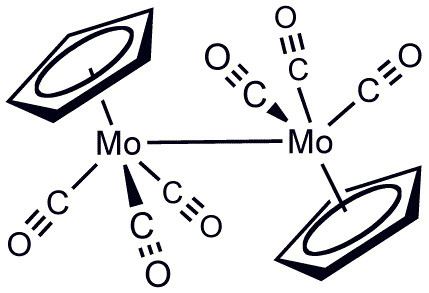Related compounds Molar mass 489.96 g/mol | Formula Mo2(η-C5H5)2(CO)6 Melting point 222 °C | |
 | ||
Appearance dark red crystalline solid | ||
Cyclopentadienylmolybdenum tricarbonyl dimer is the chemical compound with the formula Cp2Mo2(CO)6, where Cp is C5H5. This a dark red crystalline solid is air stable in solid form, but decomposes in solution when exposed to air. It is one of the most important and most accessible organomolybdenum compounds, although it has no practical uses.
Contents
Structure and synthesis
The molecule exists in two rotamers, gauche and anti. The six CO ligands are terminal and the Mo-Mo bond distance is 3.2325 Å. The compound is prepared by treatment of Mo(CO)6 in hot dicyclopentadiene. A high-yield route to the dimer involves a two-step, one-pot synthesis. In the first step Mo(CO)6 is converted in hot CH3CN to the air-sensitive Mo(CO)3(CH3CN)3.
Mo(CO)6 + 3 CH3CN → Mo(CO)3(CH3CN)3 + 3 CO2 Mo(CO)3(CH3CN)3 + 2 C5H6 → (C5H5)2Mo2(CO)6 + H2 + 6 CH3CNReactions
Thermolysis of this compound in hot solution of diglyme (bis(2-methoxyethyl)ether) results in decarbonylation, giving the tetracarbonyl, which has a formal triple bond between the Mo centers (dMoMo = 2.448 Å):
(C5H5)2Mo2(CO)6 → (C5H5)2Mo2(CO)4 + 2 COThe resulting cyclopentadienylmolybdenum dicarbonyl dimer in turn binds a variety of substrates across the metal-metal triple bond.
